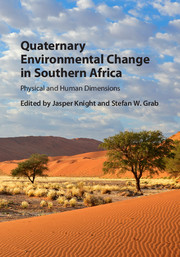Book contents
- Quaternary Environmental Change in Southern AfricaPhysical and Human Dimensions
- Quaternary Environmental Change in Southern Africa
- Copyright page
- Contents
- Contributors
- 1 The context of Quaternary environmental change in southern Africa
- 2 A brief geological history of southern Africa
- 3 A continental-scale perspective on landscape evolution in southern Africa during the Cenozoic
- 4 Hominin origins and evolution during the Neogene
- 5 Hominin evolution in Africa during the Quaternary
- 6 Quaternary environmental change on the southern African coastal plain
- 7 Dating the southern African landscape
- 8 Glacial and periglacial geomorphology
- 9 Colluvial deposits and slope instability
- 10 Desert dune environments
- 11 Changes in fluvial systems during the Quaternary
- 12 Wetlands in southern Africa
- 13 Sandy coasts
- 14 Environmental change during the Pleistocene and Holocene: Estuaries and lagoons of southern Africa
- 15 Soils and duricrusts
- 16 Karstic systems
- 17 Terrestrial ecosystem changes in the late Quaternary
- 18 Faunal evidence for mid- and late Quaternary environmental change in southern Africa
- 19 Pollen, charcoal and plant macrofossil evidence of Neogene and Quaternary environments in southern Africa
- 20 Minerogenic microfossil records of Quaternary environmental change in southern Africa
- 21 Development of the archaeological record in southern Africa during the Earlier Stone Age
- 22 Development of the archaeological record during the Middle Stone Age of South Africa
- 23 Later Stone Age hunter-gatherers and herders
- 24 Southernmost Africans, archaeology and the environment during the Holocene
- 25 Landscape–climate–human relations in the Quaternary of southern Africa
- Index
- References
5 - Hominin evolution in Africa during the Quaternary
Published online by Cambridge University Press: 05 June 2016
- Quaternary Environmental Change in Southern AfricaPhysical and Human Dimensions
- Quaternary Environmental Change in Southern Africa
- Copyright page
- Contents
- Contributors
- 1 The context of Quaternary environmental change in southern Africa
- 2 A brief geological history of southern Africa
- 3 A continental-scale perspective on landscape evolution in southern Africa during the Cenozoic
- 4 Hominin origins and evolution during the Neogene
- 5 Hominin evolution in Africa during the Quaternary
- 6 Quaternary environmental change on the southern African coastal plain
- 7 Dating the southern African landscape
- 8 Glacial and periglacial geomorphology
- 9 Colluvial deposits and slope instability
- 10 Desert dune environments
- 11 Changes in fluvial systems during the Quaternary
- 12 Wetlands in southern Africa
- 13 Sandy coasts
- 14 Environmental change during the Pleistocene and Holocene: Estuaries and lagoons of southern Africa
- 15 Soils and duricrusts
- 16 Karstic systems
- 17 Terrestrial ecosystem changes in the late Quaternary
- 18 Faunal evidence for mid- and late Quaternary environmental change in southern Africa
- 19 Pollen, charcoal and plant macrofossil evidence of Neogene and Quaternary environments in southern Africa
- 20 Minerogenic microfossil records of Quaternary environmental change in southern Africa
- 21 Development of the archaeological record in southern Africa during the Earlier Stone Age
- 22 Development of the archaeological record during the Middle Stone Age of South Africa
- 23 Later Stone Age hunter-gatherers and herders
- 24 Southernmost Africans, archaeology and the environment during the Holocene
- 25 Landscape–climate–human relations in the Quaternary of southern Africa
- Index
- References
Summary
During the Quaternary, the hominin evolutionary tree can be best characterised as bushy. Fossil discoveries in recent decades have shown that different hominin taxa co-existed more than was previously thought when Homo habilis was first deemed the earliest member of genus Homo. Such phylogenetic complexity at the origin of Homo is indicative of an adaptive radiation, in this case often attributed to a palaeoclimatic drying trend in Africa. Establishing evolutionary relationships amongst different taxa at the origins of Homo, and ultimately with the descendent species of one of them, Homo erectus, is made difficult by their mosaic of primitive and derived morphological characteristics. Linking these morphologies with coeval environmental change is made difficult by conflicting signals between regional palaeoclimate indicators. By the end of the Quaternary, hominin behavioural and cognitive changes arguably become more evident in the ‘evolving’ archaeological record of southern Africa than in its fossil record. New discoveries and new types of morphological analyses are clearly needed for sharpening phylogenetic resolution, particularly early in the Quaternary.
- Type
- Chapter
- Information
- Quaternary Environmental Change in Southern AfricaPhysical and Human Dimensions, pp. 67 - 87Publisher: Cambridge University PressPrint publication year: 2016

